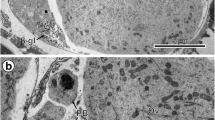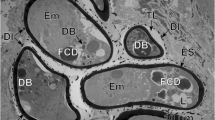Conclusions
-
1.
An attempt is made to interpret Ehrlich's and Unna's vital staining electrically.
-
2.
The main part of the virginal egg appears to be positive in the surface layer and in the “black point” of the axolotl egg.
-
5.
The developing embryo seems electronegative and extracellular in its main mass.
-
4.
It is probable that electrostatic attraction and repulsion contribute to fertilization although the manner in which these forces operate are thus far inexplicable.
-
5.
The importance of the role played by electrostatic attraction and repulsion is to be stressed.
-
6.
The fact that Na is under all conditions positive, is in contrast with the behavior of potassium which is positive in the inorganic world of solutions in distilled water while it is negative in the milieu of living cells.
-
7.
With acid violet in picric acid, rich contrast staining of living snail eggs was obtained. Around the developing egg at least three violet rings appear. Between these rings and the embryo is the egg yolk, a further ring around the embryo, whose marginal cells form a further cortical structure.
Similar content being viewed by others
Literature
Amberson, W. R., Cold Spring Harb. Symposion, 1936.
Burch and Reeser, J. Clin. Investig. 1947, quoted after E. H. Quimby, Nucleonics 4, 2, 1947.
Chaillet-Bert, Peyre et Bertillon, C. R. de Soc. Biol., Paris 97: 1676, 1927.
Einstein, A., and L. Infeld, The Evolution of Physics, Simon-Schuster, New York 1938.
Kaunitz, H., and B. Schober, Z. E. Klin. Med. 131, 192, 1937.
Keller, R., and B. Chiego, Electric Forces in the Digestive Tract, Review of Gastro-Enterology 15: 561, 1948.
Keller, R., and B. V. Pisha, Anatom. Rec. 98: 39, 1947.
Pisha, B. V., Science 108: 142, 1948.
Quimby, E. H., Am. J. Med. Sciences 214: 585, 1947. Nucleonics, 1: 2, 1947.
Shol, Mineral Metabolism 1939. Reinhold, New York.
Steubel, Handb. d. ges. Physiologie Springer, Berlin.
Waldner, M., Anat. Anzeiger 8: 541, 1893.
Warburg, Otto, Inaugural Dissertation, Berlin, 1911. Abstract in Hoppe-Seyler Z. f. Physiol. Chem., 1908.
Winternitz, Ida, in Keller's Elektrizität in der Zelle, 2nd Edit., 1925.
Author information
Authors and Affiliations
Rights and permissions
About this article
Cite this article
Keller, R., Chiego, B. Vital staining of developing eggs. Protoplasma 39, 44–54 (1949). https://doi.org/10.1007/BF01249014
Received:
Issue Date:
DOI: https://doi.org/10.1007/BF01249014




